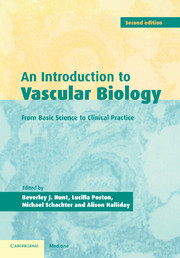Book contents
- Frontmatter
- Contents
- List of contributors
- Preface
- Part I Basic science
- 1 Vascular tone
- 2 Vascular compliance
- 3 Flow-mediated responses in the circulation
- 4 Neurohumoral regulation of vascular tone
- 5 Angiogenesis: basic concepts and the application of gene therapy
- 6 The regulation of vascular smooth muscle cell apoptosis
- 7 Wound healing: laboratory investigation and modulating agents
- Part II Pathophysiology: mechanisms and imaging
- Part III Clinical practice
- Index
1 - Vascular tone
Published online by Cambridge University Press: 07 September 2009
- Frontmatter
- Contents
- List of contributors
- Preface
- Part I Basic science
- 1 Vascular tone
- 2 Vascular compliance
- 3 Flow-mediated responses in the circulation
- 4 Neurohumoral regulation of vascular tone
- 5 Angiogenesis: basic concepts and the application of gene therapy
- 6 The regulation of vascular smooth muscle cell apoptosis
- 7 Wound healing: laboratory investigation and modulating agents
- Part II Pathophysiology: mechanisms and imaging
- Part III Clinical practice
- Index
Summary
Introduction
This chapter provides an overview of how vascular smooth muscle cells produce force and how this process is regulated. An overview inevitably involves generalizations and this tends to obscure the considerable diversity that exists in vascular smooth muscle. Such diversity is unsurprising if one recalls the variety of functions performed by blood vessels. Large arteries act as elastic conduits, smaller arteries regulate the distribution of blood flow, the microvasculature largely determines vascular resistance and fluid exchange, while the venous system undertakes a capacitive role and governs venous return to the heart. When these differences are compounded with the differences in behaviour required from blood vessels supplying different tissues, one can see that smooth muscle diversity is a positive asset that allows appropriate responses in a particular circumstance.
Owing to space constraints I have not attempted to provide comprehensive source references in this chapter. Instead, recent reviews have been cited and these should be referred to for more detailed information regarding a particular topic and original sources.
Types of stimulus for contraction and relaxation
Under physiological circumstances the primary role of differentiated (as opposed to ‘synthetic’) smooth muscle is to generate force. Normally, the vascular smooth muscle that makes up the bulk of the blood vessel wall is in a state of continual activation. The amount of force generated by smooth muscle is finely regulated by a variety of extracellular and intrinsic factors.
- Type
- Chapter
- Information
- An Introduction to Vascular BiologyFrom Basic Science to Clinical Practice, pp. 3 - 32Publisher: Cambridge University PressPrint publication year: 2002

